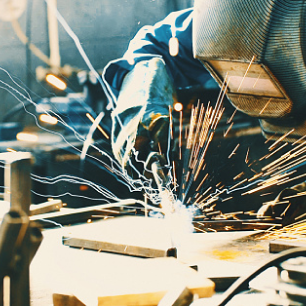Jump to:
Voltage Vortex Void Anomaly in Downhill Pipeline Welding
In 2022, while performing a welding procedure specification (WPS) test for a major gas company, a novel weld defect was discovered during the destructive testing of the pipe. These defects were found in the nick-break sections removed to visually inspect the interior weld metal structure. The defects were scattered through the final or cap passes and the weld layers under and adjacent to the cap passes.
The weld testing was requested and scheduled with a local pipeline welding contractor. This company is regularly utilized by many regional and national pipeline companies and is known to produce acceptable work consistently. A meeting was held before the scheduled test date, and the contractor and their welding crews discussed and agreed upon the testing parameters. This procedure was to be proven and added to the manual of welding procedures, which this gas company would use in subsequent work.
Welding Procedure
The procedure called for the X70M pipe to be welded with a downhill progression, and the welds were to be done with an E6010 root and hot pass sequence, followed by fill and cap passes with an E9045-P2 electrode. This procedure has been proven in previous utilization to decrease the welding time on the heavy-wall, large-diameter pipe of the gas systems found throughout America and in foreign countries. Other procedures, like the one proposed by the gas company, have shown that welding times seen in large-diameter pipe welding scenarios could be significantly reduced and that weld defects prone to procedures using cellulosic electrodes could be reduced or eliminated. These perennial problems include but are not limited to, most principally, the prevalence of cracking due to hydrogen embrittlement and cracking due to weld-strength mismatch when welding the newer, higher-tensile pipe materials, such as X70 and X80. For these reasons, many companies use high-speed, high-deposition electrodes that fit into the downhill, low-hydrogen category. The electrode used for some time in this type of welding was classified as an E7048 electrode and had performed well in this capacity, giving welders and welding contractors a faster welding electrode in the vertical (5G) position and the unlimited (6G) positions.
This test, for which the voltage vortex void (VVV) defect was first observed, was a routine WPS test for the gas company to have a downhill, low-hydrogen procedure in its welding procedure manual. In this way, they would have a procedure that a contractor would use or adhere to when performing production welds. The test pipe was secured and was compliant with the materials test report (MTR) for the X70M grade. The electrode supplied was also found to comply with the lot numbers, specifications, and classification for downhill, low-hydrogen shielded metal arc welding (SMAW). Cleaning and preparation were conducted per WPS guidelines, and fitups were approved by the welding inspector present, with appropriate fitup dimensions and high/low meeting company welding manual requirements. Proper preheat was done, and welding was allowed to proceed, starting with a 5P+ root pass, progressing through the hot pass, and completing the interior welds with a hot fill pass.
Problems Found
The welding inspector observed that the welders began to have problems with the fill and cap electrode, E9045-P2, and several instances of “stub out” (or electrode sticking) were seen and commented on to the welders. The issue discussed was the increased travel speed needed for the E9045-P2 and how traveling at slower-paced speeds, normal in cellulosic work, had to be abandoned to avoid electrode sticking and weld contamination. Welding progressed with intermittent electrode sticking issues, and restarts were made after some grinding and wire brushing.
After thirteen fill passes with E9045-P2, the 0.750-in. wall thickness pipe was flush-filled and ready to be capped, continuing with the LH90D electrode. Per the WPS, the welders turned down their amperages to affect a fuller cap weld. From the twelve o’clock position to the three o’clock position, the welders had several issues with electrode sticking and arc cessation. Careful observation by the inspectors resulted in restarts being first ground with an angle grinder and then wire-brushed before welding could be resumed. The welders objected to the grinding and prep work for restarts and stated that restarts didn’t necessarily need to be ground and brushed, as the new restart reheated and melted the stub-out material as the weld was reinitiated. As the results demonstrated, this occasion was one of the more important aspects of this procedure’s necessities.
Examination
The welding was completed, and the necessary test coupons were retrieved, resulting in all test specimens being taken to an independent testing laboratory.
All material procurement, consumable material provided, test sample fitup, and welding were monitored and closely observed by two competent Certified Welding Inspectors (CWIs). The pipe and the filler materials were documented to be clean, dry, and without any negative conditions before welding. All welding parameters and weld testing environments were documented, with all testing samples being designed, taken custody of, and transported to the independent laboratory, which is well known for its integrity and quality of workmanship.
The welding equipment provided and personally owned by the test welders was inspected and documented, including make, models, and serial numbers. Output voltages and amperages were checked, documented, and confirmed within WPS limits. Weather conditions were clear and mild, and the work was not done in any adverse conditions or extremes of temperature. Welding was started and completed inside the contractor’s shop area, with roll-up doors closed and fumes ventilated outdoors. Fitup and welding were completed in one day, and the coupon preparation was started and completed on the second day of the testing sequence.
After two days, the testing laboratory contacted the CWI and expressed concerns over indications found in some nick-break samples. Pictures of those unknown structures were sent to the CWI and were determined to be unknown and without explanation — Figs. 1 and 2. The CWI proceeded to the testing facility and took possession of the nick-break samples to examine and assess defect type and origin. Numerous inspecting colleagues were consulted without recognition or understanding of how such a defect could be produced.
Cause and Solution
Three weeks later, after careful consideration and reflection on the testing parameters and the composite contributions to the testing samples, the nature and method of producing the anomalies were determined.
When welding with high-speed, low-viscosity welding rods, such as E8045-P2, E9045-P2, or any E7048 variant, welders need a warmup or practice time to adjust to the high deposition rates of those electrodes. If they do not get that practice time, their frequency of stub out or freezing the electrode to the workpiece will contribute to the presence of this defect.
In addition to the practical factor of manual manipulation and technique mastery, the welding power source also plays a significant part in creating favorable conditions, which bring about the vortex voids in the weld metal. In particular, the increased open circuit voltage (OCV) features of portable welding machines in the last decade have been seen to be a factor that drives the presence of VVVs. It is common knowledge that with the SMAW processes, the voltage of the welding machine and its potential for striking and starting a weld is at its highest point while the welding arc is open and no welding is taking place. The current or amperage is set to a setting that the machine will adjust to as the welding arc is initiated, begins, rises, and falls as the welding work progresses. When these two factors are combined in what is known as the drooping curve character of SMAW machines, it may be observed that the voltage, after having initiated the arc and breaking down the parent metals’ resistance to current flow, will drop to a level of potential or voltage that will maintain the arc in the weld and it, too, will increase and decrease as the arc length is varied by the operator and as the resistance of the cables and other entities in the current loop are manipulated. This voltage potential and its variableness are usually benign to the weld as it progresses. However, with the advent of higher and higher OCV found on the newest models of machines, the prevalence of VVVs has increased. This contributes to that prevalence by combining stub out and high OCV.
When the welder is working with the downhill, low-hydrogen electrodes and the rate of travel is too low, the possibility of stub out is increased. When welding at high amperages, such as 150-170 A, using 3/16 in. (4.78 or 5 mm) and especially on the cover passes, the weld metal is quite liquid and has a low viscosity. Combine this phenomenon with a high OCV, such as 93 or 98 OCV, and the production of VVVs can occur. This happens quite rapidly (less than 1 second) and varies in volume due to several factors all occurring simultaneously. The VVV event occurs when the welder is welding, the weld metal is in a very liquid state, and the OCV is low, as the current needed is flowing and the weld is progressing. Next, the welder stubs out, the OCV jumps to its maximum, and a voltage jolt occurs, trying to reignite the arc but without success. The VVV is produced and solidified in the weld metal at that moment. Depending on the power source, the VVV will manifest itself as a three-pronged anomaly (see Fig. 1) not visible to the naked eye. The defects are not highly detectable by radiographic examination (RT) or ultrasonic examination (UT) and appear as lighter-density spots, similar to radiographic artifacts or droplet images to the radiographic interpreter (see Fig. 2). To physically view the VVVs, one must observe them in the destructive testing coupons, such as in a nick break. They have been incorrectly identified as hard spots (martensite), piping porosity, or simple porosity in spherical presentations. The most curious observation of the defect is that they will always be found in groups of three, which is a function of the welding power source generator construction.
The most important aspect of recognizing the VVV is what they produce in the weld’s mechanical properties. They are local hard spots due to the rapid cooling of the weld metal so that they can be localized martensite. They will always snap and break as a whole unit, starting a crack or underbead failure. Currently, scanning electron microscopy is being used to determine the microhardness of the interior surfaces of the vortices.
Conclusion
For the inspector, pipe boss, or welding supervisor, the most important aspect is to be aware of the conditions in which voltage vortices may occur:
1. Welding with downhill low-hydrogen electrodes like E7048, E8045-P2, or E9045-P2;
2. Welding with welding machines that have high OCV, such as 90 or higher; and
3. Using welders with limited or no experience welding with downhill low-hydrogen electrodes. Knowing this and being diligent in the inspection and weld observance duties, those responsible for the weld quality must watch for any weld interruptions involving an electrode freezing or sticking to the weld. When this occurs, the inspector or supervisor must require the affected weld area to be thoroughly ground out and prepped before continuing with the weld progression, not allowing the weld to be remelted and restarted by simply starting with a new electrode, as this will most likely not burn out the hardened VVV.
The benefits of this method of welding large-diameter pipe with large wall thicknesses are apparent. Weld times may be reduced by as much as half, and the welds are not as susceptible to hydrogen embrittlement as with cellulosic products due to the low hydrogen nature of the electrode class. However, careful observation by the welding supervisory or inspection personnel is vital to avoid the mechanical and metallurgical problems that the VVV will manifest, and this care must be taken to ensure sound welds.
JEFFRY STRAHAN (slaggdog17@gmail.com) is an AWS CWI, CWE, and API 1169 Pipeline Construction Inspector. He’s also a retired instructor from Weber State University, Ogden, Utah.


